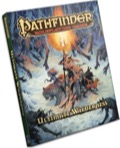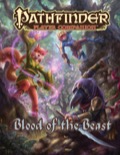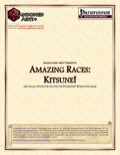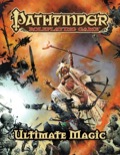Sign in to create or edit a product review. The Good, the Bad, and the ShifterUltimate Wilderness is a product which shows the best and the worst of Paizo. There are a large number of great character options and GM tools to be found here. However, there are also a number of disappointments, some of which have been becoming a bit too familiar. The Good
The Bad
The Shifter
In my opinion, the problem with the shifter is that almost all of its class features can be mimicked with the Beast Shape II spell. There really isn't much else to the shifter, and it doesn't do much that another shapeshifting class hasn't already done better. The class peaks at level 5 when it has wildshape and pounce. After that it gains very little aside from additional forms, and a feat or two that only functions when it is in a specific form. When compared to a Druid, the shifter seems to give up an unbelievable amount of power and versatility for its BAB increase. Sure, the druid is overpowered, but the shifter doesn't compare very well to any other shapeshifting classes or archetypes either. Why play a shifter who can only shapeshift, when there are other full BAB classes which can shapeshift nearly as well while also having a ton of additional class abilities (such as rage powers or vigilante talents) on top of that? It really wouldn't have taken much to make the shifter into a good class for all levels of play. Simply sprinkling in more flavor abilities from the monk, druid or ranger past 5th level would have helped. Another option would have been 4th level spellcasting. But neither of those happened, so we're stuck with a disappointing class whose main class abilities can be mimicked with a single 4th level spell. In my opinion, the shifter is really only useful for new players, low level games, or people who just don't want to deal with the complexity of other shapeshifting classes. While I can understand the benefits of having an easy to learn shapeshifting class, this doesn't mean it can't have any depth to it. The fact that the Shifter's design issues were not noticed by someone at Paizo is a bit concerning, and I'm hoping that this was a one time thing driven by the recent focus on Starfinder. Conclusion
However, the good sections of the book are *very good* and I feel bad that I didn't spend more time to talking about them. Whether or not this book is worth a hardcover purchase for you basically depends on what you wanted from the book. If you really only wanted the shifter and more class options, this may only be worth a PDF for you. If you're interested in the races, wilderness rules, and animal companion sections then a hardcover purchase may be worthwhile. Overall though, this is a very flawed hardcover that may have the most problems since Ultimate Magic (if not more). Full of flavorful character options and useful for even non-beast races.When I first saw the announcement for this book I was worried that Paizo was trying to stuff too many races into a single player companion again. Previous books with many fewer races than this one had only 2 pages of information per race, and the rest of the book was taken up by setting information that wasn't very useful for most players. It looked like the book was going to have space issues just like all the other race focused books before it. Well, where previous race focused player's companions have failed this one has succeeded. It accomplished this by being *very* to the point. Very little space is wasted. It also focused almost entirely on extremely flavorful character options. Instead of devoting pages of the book to talking about the races at the cost of character options, Paizo instead mixed the world building and flavor into the character options. Everything gives a sense of the themes of each race and a bit of its place in the world. Now, don't get me wrong, I would have loved to read pages and pages of information of the Kitsune, Tengu, and all the other races. However, I think four pages of character options for each race was the best we could hope for in a player's companion. We'll just have to hope that Paizo eventually releases a setting book about the beast races at a later date. As for the quality of the character options, I have found that for the most part everything is well thought out and useful without being overpowered. For example, the kitsune have more ways to get tails now, can get Fox Shape at level 1, and can get +2 Int instead of +2 Cha so they can be clever tricksters instead of just good manipulators. Catfolk got archetypes that allow them (and other races) to shapeshift into beast forms. I'm not a huge fan of the gripili, but they have a very interesting Fiend Keeper Medium archetype that allows a character to contain (and draw power from) an evil spirit to try and keep it from causing damage to the world. I have found that a few abilities here and there probably aren't as useful as they could be. For example, the Shapechanging Savage kitsune feat lets them get a feint as swift action after shapeshifting. However... there are action economy issues with this. You have to use an obscure racial option to get move action shapeshifting to even be able to get one attack off after the feint, and full attacks are mostly impossible. Luckily, abilities like these seem to be the exception rather than the rule. One of the best parts of this book is that about half of the character options don't actually have race restrictions, and the book even explains how many of these abilities might be learned by other races. That means there are still plenty of useful things in this book for people who don't want to play as an anthropomorphic animal. Those who do want to play as one of the beast races are in for a real treat however. The Kitsune, like many of the other 'Uncommon' races from Paizo’s Advanced Race Guide, have a fairly limited number of character options. Because of this, this pdf gives this under supported race a much needed influx of well designed Feats, Character Traits, Racial Traits and an archetype. These character options are generally well designed and well balanced. Honestly, most of the negative things I have to say about the contents of this pdf are just nitpicking rather than real problems. Here are my thoughts on the contents of this pdf
Feat-Shapechanger’s Reveal: It has heavy prereqs, but the ability to surprise your opponents with your shapeshifting is a very thematic ability. I like this one. Character Trait-Insider Psychology: Unlike most bluff traits, this one is focused on the race that Kitsune are constantly hiding among: humans! Nice touch. Character Trait-Ordinary Forms: This trait seems a bit odd to me. It gives a minor bonus to hiding in crowds, but somehow applies to both of your forms? This may be the weakest option in the book. Racial Trait-Blazing Spirit: Very well thought out and very thematic. This gives kitsune a limited use fire attack that can be used a significant number of times per day and works for both melee or ranged. It has a small amount of scaling, and will be very handy for kitsune characters at low levels when they can’t use their primary attack. Racial Trait-Gift of Tongues: Extra languages! Great trait for kitsune who want to be be better infiltrators.
Racial Trait-Ki Pool: Ki is a theme in this book, and I guess it makes sense considering kitsune are asian themed. Stacks with ki pools from other classes and even lets monks use Cha for their ki pool... this ability is almost too good. However, considering neither monks nor ninjas are exactly top top tier, I can’t hold that against the designer. A very nice ability. And finally: The White Furred Oracle archetype.
Nine Mysteries: Nine spells nicely fits with the nine tailed fox theme, though the ability to pick and choose which spells actually replace those from your original mystery seems more powerful than usual. Then again, it may be balanced with this nastier than normal curse... Mystic Kama:Another ability taken directly from kitsune lore, the oracle’s curse is replaced with a ‘star gem’. This gem is the oracle’s source of power, and he needs it to reliably cast spells similarly to an arcane bonded item. Also, just like in the legends, the kitsune becomes afraid of dogs. A very well thought out theme for an oracle’s curse. The only thing that bothers me about it is that it doesn’t have the usual progression of giving the oracle abilities that are tied to the curse as he gains levels. Ki Pool and Ki Talents: A very interesting set of abilities that replace one or more oracle mysteries. The kitsune gains a ki pool, and can also gain ninja tricks. This can lead to an very unusual set of abilities and playstyle for an oracle. It also means the character could multiclass into either monk or ninja. While I may have sounded critical of some of the contents of this pdf, overall I am quite pleased with it. This thing doubles the number of options available to kitsunes, and the contents are generally well written and well thought out. This is a very good buy for just a dollar, and a must buy for anyone who who wants to give kitsune players some unique options aside from simply building an enchantment sorcerer. Excellent book, but needed more editing and balancing.As both a player and a GM, I'm quite happy to have my hands on Ultimate Magic. The Magus class is definitely the star of the book, but there are plenty of other great options such as additional archetypes, feats, spells. One of my players is also using the wordcasting system on his sorcerer, and he is having a field day with it. However, this book has some major editing issues. Certain Archetypes such as the Sythesist currently aren't usable without GM houserules to determine how exactly its abilities work. Other parts of the book refer to feats or spells that were cut out. There are also some problems with the book inserting powers or abilities that just seem too weak (such as ranger traps). None of this makes the book unusable since a GM can make his own adjustments as necessary, but these problems will still cause headaches. I'm giving this book four stars because I believe that it will be just fine after Paizo does some erratas for it, but I am annoyed that I am going to have to refer to on online document for information that should have been done right in the first place. |







